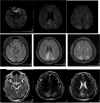Eclampsia with hypothyroidism complicated with posterior reversible encephalopathy syndrome-a case report
- PMID: 36765280
- PMCID: PMC9911940
- DOI: 10.1186/s12883-023-03068-y
Eclampsia with hypothyroidism complicated with posterior reversible encephalopathy syndrome-a case report
Abstract
Background: Posterior reversible encephalopathy syndrome (PRES) is a rare neurological disorder with complex physiopathological mechanisms that have not been fully understood. Early identification is of great prognostic significance, of which the symptoms and radiological abnormalities can be completely reversed. If the diagnosis and treatment are delayed, ischemia and massive infarction may be developed in some patients. Posterior reversible encephalopathy syndrome (PRES) has been reported mainly in association with postpartum eclampsia, which have been rarely reported, while the association with hypothyroidism has not been reported at home or abroad.
Case presentation: Here we report on a pregnant 29-year-old with multipara and a chief complication of hypothyroidism. She presented in the emergency department with frequent attacks of severe headache symptoms resulting from reversible cerebral vasoconstriction syndrome (RCVS), accompanied with prenatal eclampsia. PRES was determined by radiological examination.
Conclusion: To the best of our knowledge, this is the first case of PRES complicated by hypothyroidism and prepartum eclampsia.Clinicians should be alert for the co-occurence of eclampsia, PRES, and RCVS when patients have convulsions after a typical throbbing headache. Moreover, regular monitoring of thyroid function during pregnancy should also occupy certain special attention.
Keywords: Case report; Eclampsia; Hypothyroidism; Posterior reversible encephalopathy syndrome; Reversible cerebral vasoconstriction syndrome.
© 2023. The Author(s).
Conflict of interest statement
The authors declare that they have no conflict of interest.
Figures
Similar articles
-
Posterior reversible encephalopathy syndrome associated with reversible cerebral vasoconstriction syndrome in a patient presenting with postpartum eclampsia: A case report.J Gynecol Obstet Hum Reprod. 2019 Jun;48(6):431-434. doi: 10.1016/j.jogoh.2019.03.019. Epub 2019 Mar 21. J Gynecol Obstet Hum Reprod. 2019. PMID: 30905853
-
Posterior Reversible Leucoencephalopathy Syndrome: Case Series, Comments, and Diagnostic Dilemma.Curr Neurol Neurosci Rep. 2023 Aug;23(8):433-449. doi: 10.1007/s11910-023-01281-3. Epub 2023 Jun 28. Curr Neurol Neurosci Rep. 2023. PMID: 37378723 Review.
-
Posterior reversible encephalopathy syndrome in a patient with late postpartum eclampsia.Medicine (Baltimore). 2023 Nov 10;102(45):e35867. doi: 10.1097/MD.0000000000035867. Medicine (Baltimore). 2023. PMID: 37960797 Free PMC article.
-
Posterior reversible encephalopathy syndrome as a complication of pre-eclampsia in the early postpartum period.BMJ Case Rep. 2019 Jul 16;12(7):e228954. doi: 10.1136/bcr-2018-228954. BMJ Case Rep. 2019. PMID: 31315841 Free PMC article.
-
Posterior Reversible Encephalopathy Syndrome and Reversible Cerebral Vasoconstriction Syndrome as Syndromes of Cerebrovascular Dysregulation.Continuum (Minneap Minn). 2021 Oct 1;27(5):1301-1320. doi: 10.1212/CON.0000000000001037. Continuum (Minneap Minn). 2021. PMID: 34618761 Review.
References
-
- Which anticonvulsant for women with eclampsia? Evidence from the Collaborative Eclampsia Trial. Lancet. 1995;345(8963):1455–63. - PubMed
Publication types
MeSH terms
Grants and funding
LinkOut - more resources
Full Text Sources
Medical


